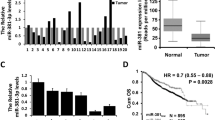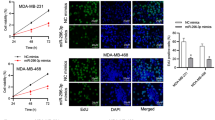Abstract
MicroRNAs have been implicated in regulating diverse cellular pathways. Emerging evidence indicate that the miR-17-92 cluster may have a causal role in breast cancer tumorigenesis as a novel class of oncogenes, but the role of these miRNAs in breast cancer invasion and migration remains unexplored. The aims of this study were to verify the effect of miR-17-5p (an important member of the miR-17-92 cluster) on the invasive and migratory ability of breast cancer cells. The matching of miR-17-5p and HMG box-containing protein 1 (HBP1) was predicted by TargetScan and confirmed by DNA constructs and luciferase target assay. The expression levels of miR-17-5p and its candidate target-HBP1 in MCF7 and MDA-MB-231 breast cancer cells were measured by real-time PCR and western blotting. Effects of miR-17-5p in cell cycle progression, proliferation, invasion and migration were evaluated by flow cytometry assay, 3-(4,-dimethy -lthiazol-2-yl)-2,-diphenyl -tetrazoliumbromide assay, soft-agar colony formation assay, and transwell invasive and migratory assay, respectively. The results showed that miR-17-5p was highly expressed in high-invasive MDA-MB-231 breast cancer cells but not in low-invasive MCF-7 breast cancer cells. Over-expression of miR-17-5p in MCF-7 cells rendered them the invasive and migratory abilities by targeting HBP1/β-catenin pathway. On the other hand, down-regulation of endogenous miR-17-5p suppressed the migration and invasion of MDA-MB-231 cells in vitro. These findings suggest that miR-17-5p plays an important role in breast cancer cell invasion and migration by suppressing HBP1 and subsequent activation of Wnt/β-catenin.






Similar content being viewed by others
Abbreviations
- HBP1:
-
HMG box-containing protein 1
- miRNA:
-
microRNA
- PTEN:
-
Phosphatase and tensin homolog
- BIM:
-
Bcl-2 interacting mediator of cell death
- H-DMEM:
-
High glucose of Dulbecco’s modified Eagle’s medium
- MTT:
-
3-(4, -dimethy -lthiazol-2-yl)-2, -diphenyl -tetrazoliumbromide
- BSA:
-
Bovine serum albumin
- MKK4:
-
MAP kinase kinase 4
- NMe1:
-
Non-metastatic cells 1
- Timp1:
-
Tissue inhibitor of matrix metalloproteinase-1
- NMe2:
-
Non-metastatic cells 2
- KAI1:
-
CD82 molecule (metastasis suppressor Kangai-1 homolog)
- SDF-1:
-
Stromal cell-derived factor 1
References
Bartel DP (2004) MicroRNAs: genomics, biogenesis, mechanism, and function. Cell 116:281–297
Yekta S, Shih IH, Bartel DP (2004) MicroRNA-directed cleavage of HOXB8 mRNA. Science 304:594–596
Vasudevan S, Tong Y, Steitz JA (2007) Switching from repression to activation: microRNAs can up-regulate translation. Science 318:1931–1934
O’Donnell KA, Wentzel EA, Zeller KI, Dang CV, Mendell JT (2005) c-Myc-regulated microRNAs modulate E2F1 expression. Nature 435:839–843
Lu Y, Thomson JM, Wong HY, Hammond SM, Hogan BL (2007) Transgenic over-expression of the microRNA miR-17–92 cluster promotes proliferation and inhibits differentiation of lung epithelial progenitor cells. Dev Biol 310:442–453
Jopling CL, Yi M, Lancaster AM, Lemon SM, Sarnow P (2005) Modulation of hepatitis C virus RNA abundance by a liver-specific microRNA. Science 309:1577–1581
Fontana L, Pelosi E, Greco P, Racanicchi S, Testa U, Liuzzi F, Croce CM, Brunetti E, Grignani F, Peschle C (2007) MicroRNAs 17–5p-20a–106a control monocytopoiesis through AML1 targeting and M-CSF receptor upregulation. Nat Cell Biol 9:775–787
Volinia S, Calin GA, Liu CG, Ambs S, Cimmino A, Petrocca F, Visone R, Iorio M, Roldo C, Ferracin M, Prueitt RL, Yanaihara N, Lanza G, Scarpa A, Vecchione A, Negrini M, Harris CC, Croce CM (2006) A microRNA expression signature of human solid tumors defines cancer gene targets. Proc Natl Acad Sci 103:2257–2261
Ma L, Teruya-Feldstein J, Weinberg RA (2007) Tumour invasion and metastasis initiated by microRNA-10b in breast cancer. Nature 449:682–688
Tavazoie SF, Alarcón C, Oskarsson T, Padua D, Wang Q, Bos PD, Gerald WL, Massagué J (2008) Endogenous human microRNAs that suppress breast cancer metastasis. Nature 451:147–152
Valastyan S, Reinhardt F, Benaich N, Calogrias D, Szász AM, Wang ZC, Brock JE, Richardson AL, Weinberg RA (2009) A pleiotropically acting microRNA, miR-31, inhibits breast cancer metastasis. Cell 137:1032–1046
Mendell JT (2008) miRiad roles for the miR-17–92 cluster in development and disease. Cell 133:217–222
Petrocca F, Visone R, Onelli MR, Shah MH, Nicoloso MS, de Martino I, Iliopoulos D, Pilozzi E, Liu CG, Negrini M, Cavazzini L, Volinia S, Alder H, Ruco LP, Baldassarre G, Croce CM, Vecchione A (2008) E2F1-regulated microRNAs impair TGFβ-dependent cell cycle arrest and apoptosis in gastric cancer. Cancer Cell 13:272–286
Sylvestre Y, De Guire V, Querido E, Mukhopadhyay UK, Bourdeau V, Major F, Ferbeyre G, Chartrand P (2007) An E2F/miR-20a autoregulatory feedback loop. J Biol Chem 282:2135–2143
Xiao C, Srinivasan L, Calado DP, Patterson HC, Zhang B, Wang J, Henderson JM, Kutok JL, Rajewsky K (2008) Lymphoproliferative disease and autoimmunity in mice with increased miR-17–92 expression in lymphocytes. Nat Immunol 9:405–414
Johnson DG (2007) The paradox of E2F1: oncogene and tumor suppressor gene. Mol Carcinog 27:151–157
Lu J, Getz G, Miska EA, Alvarez-Saavedra E, Lamb J, Peck D, Sweet-Cordero A, Ebert BL, Mak RH, Ferrando AA, Downing JR, Jacks T, Horvitz HR, Golub TR (2005) MicroRNA expression profiles classify human cancers. Nature 435:834–838
Zhang L, Huang J, Yang N, Greshock J, Megraw MS, Giannakakis A, Liang S, Naylor TL, Barchetti A, Ward MR, Yao G, Medina A, O′brien-Jenkins A, Katsaros D, Hatzigeorgiou A, Gimotty PA, Weber BL, Coukos G (2006) microRNAs exhibit high frequency genomic alterations in human cancer. Proc Natl Acad Sci 103:9136–9141
Gupta GP, Massagu J (2006) Cancer metastasis: building a framework. Cell 127:679–695
Weigelt B, Peterse JL, van’t Veer LJ (2005) Breast cancer metastasis: markers and models. Nat Rev Cancer 5:591–602
Sampson EM, Haque ZK, Ku MC, Tevosian SG, Albanese C, Pestell RG, Paulson KE, Yee AS (2001) Negative regulation of the Wnt/β-catenin pathway by the transcriptional repressor HBP1. EMBO J 20:4500–4511
Paulson KE, Rieger-Christ K, McDevitt MA, Kuperwasser C, Kim J, Unanue VE, Zhang X, Hu M, Ruthazer R, Berasi SP, Huang CY, Giri D, Kaufman S, Dugan JM, Blum J, Netto G, Wazer DE, Summerhayes IC, Yee AS (2007) Alterations of the HBP1 transcriptional repressor are associated with invasive breast cancer. Cancer Res 67:6136–6145
Shih HH, Xiu M, Yee AS (2001) HMG box transcriptional repressor HBP1 maintains a proliferation barrier in differentiated liver tissue. Mol Cell Biol 21:5723–5732
Yee AS, Paulson EK, McDevitt MA, Rieger-Christ K, Summerhayes I, Berasi SP, Kim J, Huang CY, Zhang X (2004) The HBP1 transcriptional repressor and the p38 MAP kinase: unlikely partners in G1 regulation and tumor suppression. Gene 336:1–13
Qin X, Zhang H, Zhou X, Wang C, Zhang H, Zhang X, Ye L (2007) Proliferation and migration mediated by Dkk-1/Wnt/β-catenin cascade in a model of hepatocellular carcinoma cells. Transl Res 150:281–294
Wang Z, Ma Q (2007) Beta-catenin is a promising key factor in the SDF-1/CXCR4 axis on metastasis of pancreatic cancer. Med Hypotheses 69:816–820
Yang J, Mani SA, Donaher JL, Ramaswamy S, Itzykson RA, Come C, Savagner P, Gitelman I, Richardson A, Weinberg RA (2004) Twist, a master regulator of morphogenesis, plays an essential role in tumor metastasis. Cell 117:927–939
Tetsu O, McCormick F (1999) Beta-catenin regulates expression of cyclin D1 in colon carcinoma cells. Nature 398:422–426
Howe LR, Brown AM (2004) Wnt signaling and breast cancer. Cancer Biol Ther 3:36–41
Yu Z, Wang C, Wang M, Li Z, Casimiro MC, Liu M, Wu K, Whittle J, Ju X, Hyslop T, McCue P, Pestell RG (2008) A cyclin D1/microRNA 17/20 regulatory feedback loop in control of breast cancer cell proliferation. J Cell Biol 182:509–517
Ghosh-Choudhury T, Mandal CC, Woodruff K, St Clair P, Fernandes G, Choudhury GG, Ghosh-Choudhury N (2009) Fish oil targets PTEN to regulate NFkappaB for downregulation of anti-apoptotic genes in breast tumor growth. Breast Cancer Res Treat 118:213–228
Davies MA, Kim SJ, Parikh NU, Dong Z, Bucana CD, Gallick GE (2002) Adenoviral mediated expression of MMAC/PTEN inhibits proliferation and metastasis of human prostate cancer cells. Clin Cancer Res 8:1904–1914
Bandyopadhyay S, Pai SK, Hirota S, Hosobe S, Tsukada T, Miura K, Takano Y, Saito K, Commes T, Piquemal D, Watabe M, Gross S, Wang Y, Huggenvik J, Watabe K (2004) PTEN up-regulates the tumor metastasis suppressor gene Drg-1 in prostate and breast cancer. Cancer Res 64:655–7660
Zhu S, Wu H, Wu F, Nie D, Sheng S, Mo YY (2008) MicroRNA-21 targets tumor suppressor genes in invasion and metastasis. Cell Res 18:350–359
Tamura M, Gu J, Matsumoto K, Aota S, Parsons R, Yamada KM (1998) Inhibition of cell migration, spreading, and focal adhesions by tumor suppressor PTEN. Science 280:1614–1617
Teng DH, Perry WL 3rd, Hogan JK, Baumgard M, Bell R, Berry S, Davis T, Frank D, Frye C, Hattier T, Hu R, Jammulapati S, Janecki T, Leavitt A, Mitchell JT, Pero R, Sexton D, Schroeder M, Pi-Hsia S, Swedlund B, Kyriakis JM, Avruch J, Bartel P, Wong AK, Oliphant A, Thomas A, Skolnick MK, Tavtigian SV (1997) Human mitogen-activated protein kinase kinase 4 as a candidate tumor suppressor. Cancer Res 57:4177–4182
Zhao H, Jhanwar-Uniyal M, Datta PK, Yemul S, Ho L, Khitrov G, Kupershmidt I, Pasinetti GM, Ray T, Athwal RS, Achary MP (2004) Expression profile of genes associated with antimetastatic gene: nm23-mediated metastasis inhibition in breast carcinoma cells. Int J Cancer 109:65–70
Visse R, Nagase H (2003) Matrix metalloproteinases and tissue inhibitors of metalloproteinases: structure, function, and biochemistry. Circ Res 92:827–839
Acknowledgments
This work was supported by grants from the “863 Projects” of Ministry of Science and Technology of People’s Republic of China (No. 2006AA02A109, 2006AA02A115), National Natural Science Foundation of China (No. 30830052, 30911130363, U0970181), Beijing Ministry of Science and Technology (No. D07050701350701) and major national science and technology project (No. 2008ZX09101-044, 2009ZX09503-025).
Author information
Authors and Affiliations
Corresponding author
Electronic supplementary material
Below is the link to the electronic supplementary material.
10549_2010_954_MOESM2_ESM.tif
miR-17-5p inhibitor suppressed the colony growth ability of 231 cells in soft agar (n=4) in general imaging (TIFF 15055 kb)
10549_2010_954_MOESM3_ESM.tif
Inhibition of endogenous miR-17-5p almost failed to suppresses activities of MCF7 cells in vitro (a) MTT assay and (b) colony formation assay showed the slight inhibition of MCF7 cell proliferation and colony formation by miR-17-5p knockdown. (c) and (d) Transwell invasion and migration assays on MCF7 cells indicated down-regulations of miR-17-5p failed to decrease cell invasive and migratory ability. Data represent the mean ±SD of at least 3 independent experiments *P<0.05, **P<0.01, ***P<0.001 (TIFF 21222 kb)
10549_2010_954_MOESM4_ESM.tif
HBP1, but not PTEN, is the direct target of miR-17-5p in breast cancer cells (a) Western blot and real-time PCR eliminated PTEN as a direct target of miR-17-5p in breast cancer cells. (b) The effect of miR-17-5p inhibitor on the luciferase activity of MCF7 cells (TIFF 1569 kb)
Rights and permissions
About this article
Cite this article
Li, H., Bian, C., Liao, L. et al. miR-17-5p promotes human breast cancer cell migration and invasion through suppression of HBP1. Breast Cancer Res Treat 126, 565–575 (2011). https://doi.org/10.1007/s10549-010-0954-4
Received:
Accepted:
Published:
Issue Date:
DOI: https://doi.org/10.1007/s10549-010-0954-4




